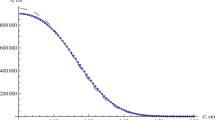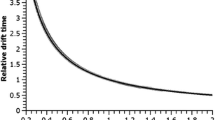Abstract
We present a simple model to describe the line-profile of velocity modulated ions. This model is based on Langevin's theory of the mobility and on the independence of the electric field strength on the discharge current in the ideal positive column. A comparison of time constants responsible for the drift of the ions, the concentration, and the ignition and extinction of the discharge itself is essential for a rough understanding of the velocity modulation. The behaviour of H3O+ ions in an ac glow discharge was examined. Under our experimental conditions the line-profile can be explained by a temporal dependence of the velocity which is close to a square-wave. Due to this particular temporal dependence the amplitude of the signal only depends on the concentration modulation, while the line-shape is a simple difference line-profile.
Similar content being viewed by others
References
C.S. Gudeman, M.H. Begemann, J. Pfaff, R.J. Saykally: Phys. Rev. Lett.50, 727 (1983)
T. Oka: Phys. Rev. Lett.45, 531 (1980)
C.S. Gudeman, R.J. Saykally: Ann. Rev. Phys. Chem.35, 387 (1984)
T.J. Sears: J. Chem. Soc. Faraday Trans. II83, 111 (1987)
N.N. Haese, F.S. Pan, T. Oka: Phys. Lett.50, 1575 (1983)
F.S. Pan, T. Oka: Phys. Rev. A36, 2297 (1987)
G.H. Wannier: The Bell Tech. J.32, 170 (1953)
P. Langevin: Annales de Chimie et de Physique Series 8,5, 245 (1905), see also Appendix II in [12]
K. Wiesemann:Einführung in die Gaselektronik (Teubner, Stuttgart 1976)
CRC Handbook of Chemistry and Physics 68th ed. 1987–1988, ed. by R.C. Weast (CRC Boca Raton, Florida 1987)
Landolt-Börnstein “Zahlenwerte und Funktionen”, I. Band 3. Teil Molekeln II (Springer, Berlin 1951) pp. 510f.
W. McDaniel:Collision Phenomena in Ionized Gases. (Wiley, New York 1964)
H.S. Johnston:Gas Phase Reaction Rate Theory (The Ronald Press Co., New York 1966)
G. Giomousis, D.P. Stevenson: J. Chem. Phys.29, 294 (1958)
F. Reif:Fundamentals of Statistical and Thermal Physics (McGraw-Hill, Tokyo 1965)
R. Becker:Theorie der Wärme (Springer, Berlin 1985)
R. Saykally: Private communication
H. Adams, R. Brüggemann, P. Dietrich, D. Kirsten, H. Solka, W. Urban: Opt. Soc. of Am. B2, 815–828 (1985)
D. Reinert, H. Solka, W. Zimmermann, A. Stahn, W. Urban: J. Phys. E (1988) (in press)
W. Schottky, J. v. Issendorf: Z. Physik31, 163 (1925)
A. von Engel:Ionized Gases (Oxford University Press, London 1965)
Th. Wasserrab: Z. Angew. Physik7, 176 (1955)
Author information
Authors and Affiliations
Rights and permissions
About this article
Cite this article
Solka, H., Zimmermann, W., Reinert, D. et al. A simple model for the velocity modulation detection technique of molecular ions. Appl. Phys. B 48, 235–242 (1989). https://doi.org/10.1007/BF00694351
Received:
Accepted:
Issue Date:
DOI: https://doi.org/10.1007/BF00694351




